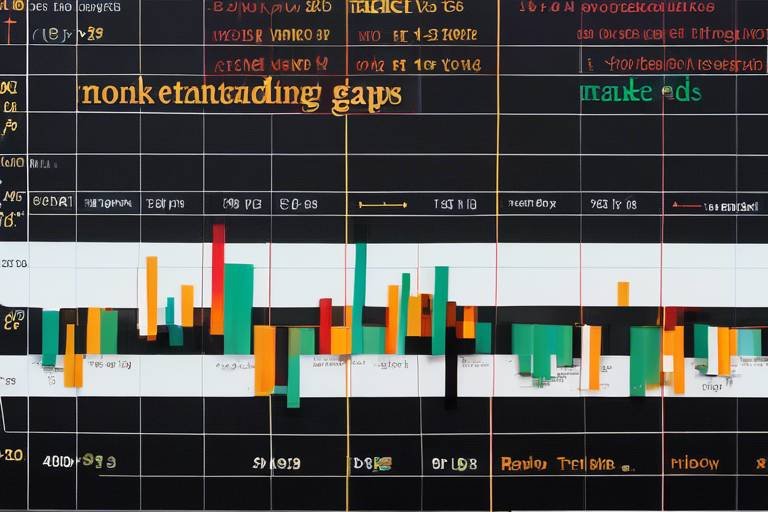How to Analyze Market Sentiment for Trading Strategies
In the world of trading, understanding the pulse of the market can be the difference between a profitable trade and a costly mistake. Market sentiment is not just a buzzword; it’s a powerful indicator of how traders feel about a particular security or the market as a whole. Imagine trying to navigate a ship through stormy seas without a compass—this is what trading without grasping market sentiment feels like. By analyzing trader emotions and opinions, you can enhance your trading strategies and make more informed decisions. So, let’s dive into the depths of market sentiment and explore how it can shape your trading journey.
Market sentiment encapsulates the overall attitude of traders towards a specific security or the market itself. It reflects the collective emotions, opinions, and behaviors of market participants. Think of it as the mood of the market; when traders are optimistic, prices tend to rise, and when they are pessimistic, prices often fall. This sentiment can be influenced by various factors, including economic indicators, news events, and even social media trends. Understanding market sentiment is crucial because it can lead to significant price movements, often before any fundamental changes occur. By keeping an eye on sentiment, traders can position themselves advantageously, anticipating market shifts rather than reacting to them.
To effectively gauge market sentiment, traders have a variety of indicators at their disposal. These tools can provide valuable insights into the emotions driving price movements. Below are some of the most effective indicators:
- Surveys and Polls: These are direct methods to gather opinions from traders and investors.
- Sentiment Indexes: These indexes aggregate data from various sources to provide a snapshot of market sentiment.
- Social Media Analytics: Analyzing trends and discussions on platforms like Twitter and Reddit can reveal public sentiment.
Surveys and polls are invaluable tools for gauging trader sentiment. They allow traders to tap into the collective mindset of the market by gathering insights from a broader audience. For instance, when a survey indicates that a significant percentage of investors are feeling bullish about a stock, it could signal a potential price increase. On the flip side, if the majority are bearish, it might be a sign to tread carefully. Utilizing these tools effectively requires not only collecting data but also understanding how to interpret it in the context of market dynamics.
The Consumer Confidence Index (CCI) is a key indicator of market sentiment. It measures how optimistic or pessimistic consumers are regarding their financial situation and the economy. A high CCI suggests that consumers are likely to spend more, which can drive economic growth and, consequently, boost stock prices. Conversely, a low CCI often indicates economic uncertainty, leading to cautious trading behavior. Understanding how the CCI is calculated and its implications can help traders make informed decisions.
Investor sentiment surveys provide insights into the emotions of market participants. These surveys can take various forms, including weekly or monthly reports that gauge investor attitudes toward the market. For example, if a survey shows that a large percentage of investors are feeling fearful, it could indicate a market correction is on the horizon. By staying updated on these surveys, traders can adjust their strategies accordingly, positioning themselves to capitalize on potential market movements.
In today’s digital age, social media platforms are a goldmine for sentiment data. Analyzing trends and discussions on platforms like Twitter, Facebook, and Reddit can offer real-time insights into public sentiment. For instance, a sudden spike in discussions about a particular stock can indicate growing interest or concern among traders. By leveraging social media analytics, traders can enhance their understanding of market sentiment and make more informed trading decisions.
Once sentiment data is collected, interpreting it effectively is crucial for successful trading. This involves analyzing sentiment indicators and correlating them with price movements. Understanding the nuances between quantitative and qualitative analysis can provide a more comprehensive view of market sentiment. Quantitative analysis relies on numerical data, while qualitative analysis focuses on the emotional aspects of trader sentiment. Balancing both approaches can yield optimal results, helping traders navigate the complexities of the market.
Understanding the difference between quantitative and qualitative sentiment analysis is essential for traders. Quantitative analysis can provide hard data on market trends, while qualitative analysis offers insights into the emotions and motivations driving those trends. For example, if quantitative data shows increasing stock prices, but qualitative analysis reveals widespread fear among investors, it may indicate a potential reversal. By integrating both methods, traders can develop a more nuanced understanding of market sentiment.
Recognizing market trends based on sentiment analysis can significantly enhance trading strategies. By correlating shifts in sentiment with price movements, traders can identify potential entry and exit points. For instance, if sentiment begins to shift from bearish to bullish, it may indicate a buying opportunity. Staying attuned to these trends allows traders to act proactively, rather than reactively, which can be the key to successful trading.
Incorporating sentiment analysis into trading strategies can dramatically improve decision-making. By blending sentiment insights with technical and fundamental analysis, traders can create a more robust trading plan. This involves not only understanding market sentiment but also being adaptable to changes as they occur.
A well-defined trading plan that includes sentiment analysis can significantly increase success rates. Here are some steps to create an effective trading strategy:
- Define your trading goals and risk tolerance.
- Incorporate sentiment indicators into your analysis.
- Regularly review and adjust your plan based on market conditions.
Continuous monitoring and adjustment of trading strategies based on sentiment shifts are vital. The market is dynamic, and trader emotions can change rapidly in response to news events or economic indicators. By remaining adaptable and responsive to these shifts, traders can better position themselves for success. It’s like surfing; you need to ride the waves and adjust your stance as conditions change to maintain your balance.
Q: What is market sentiment?
A: Market sentiment refers to the overall attitude of traders toward a particular security or market, which can influence price movements.
Q: How can I measure market sentiment?
A: Market sentiment can be measured using various indicators, including surveys, sentiment indexes, and social media analytics.
Q: Why is sentiment analysis important for trading?
A: Sentiment analysis helps traders understand the emotional landscape of the market, allowing them to anticipate price movements and make informed decisions.
Q: Can sentiment change quickly?
A: Yes, sentiment can change rapidly in response to news events, economic indicators, or shifts in public opinion, making it crucial for traders to stay informed.

Understanding Market Sentiment
Market sentiment is a powerful force that drives the financial markets. It reflects the overall attitude of traders and investors towards a particular security or market, essentially capturing the collective emotions and opinions that influence buying and selling decisions. Understanding market sentiment is crucial for any trader looking to navigate the often unpredictable waters of the stock market.
Imagine the market as a giant ocean, where waves of optimism and pessimism rise and fall, impacting the direction of stocks and commodities. When sentiment is positive, it’s like a rising tide that lifts all boats; prices soar as traders rush to buy. Conversely, when sentiment turns negative, it can create a storm, causing prices to plummet as fear drives traders to sell. This emotional landscape is what makes sentiment analysis a vital component of trading strategies.
So, why does market sentiment matter? Well, it can significantly influence price movements. For instance, even if a company reports strong earnings, if the market sentiment is bearish, the stock price may still decline. This phenomenon underscores the importance of gauging the mood of the market. Traders who can accurately assess sentiment are often better equipped to make informed decisions, whether that means entering a position or deciding to hold off.
To fully grasp market sentiment, it’s essential to consider various factors that contribute to it. These can include:
- Economic Indicators: Reports such as employment rates, GDP growth, and inflation can sway trader sentiment.
- News Events: Major news, whether positive or negative, can trigger swift changes in sentiment.
- Market Trends: The prevailing trend in the market can shape traders' outlooks, with bullish trends fostering optimism and bearish trends breeding caution.
Furthermore, market sentiment is not static; it evolves constantly as new information becomes available. Traders need to stay vigilant, using various tools and indicators to monitor sentiment shifts. By doing so, they can better anticipate market movements and adjust their strategies accordingly.
In conclusion, understanding market sentiment is not just about reading charts or analyzing data; it’s about tapping into the psychology of the market. By recognizing the emotional drivers behind price movements, traders can enhance their strategies, making more informed decisions that align with the market's current mood. The ability to read sentiment effectively can be the difference between a successful trade and a costly mistake.

Key Indicators of Market Sentiment
When it comes to trading, understanding market sentiment is akin to reading the mood of a crowd at a concert. Just as a performer can sense the energy of the audience and adjust their performance accordingly, traders must gauge the sentiments of their peers to make informed decisions. There are several key indicators that can help traders assess market sentiment effectively. These indicators can range from traditional surveys to modern social media analytics, each providing unique insights into the collective emotions of market participants.
One of the most reliable ways to measure market sentiment is through surveys and polls. These tools can gather opinions from a wide array of traders, ranging from retail investors to institutional players. For instance, when conducting a survey, traders might ask questions like, "Do you believe the market will rise in the next month?" The responses can reveal the prevailing sentiment, which can be crucial for predicting future price movements.
Another significant indicator is the Consumer Confidence Index (CCI). This index reflects how optimistic or pessimistic consumers are regarding their financial situation and the economy as a whole. A high CCI typically indicates that consumers are willing to spend money, which can lead to increased corporate profits and, subsequently, rising stock prices. Conversely, a low CCI can signal economic troubles ahead. Understanding how to interpret the CCI can give traders a leg up when making decisions.
Moreover, investor sentiment surveys are also invaluable. These surveys often focus on the feelings of investors about the market's direction. For example, they may ask participants whether they feel bullish or bearish about specific stocks or the market in general. By analyzing the results, traders can gauge whether the market is overly optimistic or pessimistic, which can indicate potential reversals or continuations in market trends.
In today's digital age, social media analytics has emerged as a powerful tool for assessing market sentiment. Platforms like Twitter, Facebook, and Reddit provide a treasure trove of information regarding public opinion on various stocks and market conditions. Traders can track hashtags, keywords, and trending topics to see what the general sentiment is among retail investors. For instance, a sudden spike in positive tweets about a particular stock can indicate growing interest and potential upward movement in its price.
To summarize, the key indicators of market sentiment include:
- Surveys and Polls
- Consumer Confidence Index (CCI)
- Investor Sentiment Surveys
- Social Media Analytics
By leveraging these indicators, traders can gain a deeper understanding of market dynamics and enhance their trading strategies. It’s not just about the numbers; it’s about understanding the emotions and psychology behind those numbers. As the saying goes, "The market can remain irrational longer than you can remain solvent." So, keeping a finger on the pulse of market sentiment can be the difference between success and failure in trading.

Surveys and Polls
When it comes to understanding market sentiment, are like the pulse of the trading community. They provide a snapshot of how traders feel about the market at any given moment. Imagine trying to navigate through a foggy landscape without a compass; that’s what trading can feel like without these valuable tools. By gathering insights from a broad audience, traders can better gauge the general mood and make more informed decisions.
Surveys can take many forms, from formal questionnaires distributed by financial institutions to informal polls conducted on social media platforms. Each type offers unique insights into trader emotions. For instance, a well-structured survey can reveal whether traders are feeling bullish or bearish, while a quick poll on Twitter might highlight immediate reactions to market news. The key is to choose the right method for the information you seek.
One of the most effective ways to utilize surveys is to analyze the results in conjunction with other market data. For example, if a survey indicates that a majority of traders are feeling optimistic about a particular stock, and the technical indicators are also bullish, it could signal a strong buying opportunity. Conversely, if sentiment is overwhelmingly negative but the technicals suggest a potential reversal, it might be wise to tread carefully.
Here are a few types of surveys that traders often rely on:
- Market Sentiment Surveys: These surveys are designed specifically to measure trader sentiment and often ask participants to express their outlook on various assets.
- Consumer Confidence Surveys: While primarily focused on consumer behavior, these surveys can also provide insights into broader market sentiment, especially in relation to economic indicators.
- Investor Sentiment Indexes: These indexes compile data from various surveys to create a comprehensive view of investor sentiment at a particular time.
The results from these surveys can be quite revealing. For example, if a significant portion of respondents expresses doubt about the sustainability of a market rally, it may indicate that a correction is on the horizon. On the other hand, if most traders are feeling confident and optimistic, it could reinforce the current trend. The ability to read these signals can be the difference between a profitable trade and a costly mistake.
In conclusion, integrating surveys and polls into your trading strategy is not just about gathering data; it’s about understanding the emotional landscape of the market. By keeping a finger on the pulse of trader sentiment, you can make decisions that are not only informed by numbers but also by the collective mood of the trading community. So, the next time you’re considering a trade, don’t forget to check the sentiment through surveys and polls. It might just give you the edge you need to succeed.

Consumer Confidence Index
The Consumer Confidence Index (CCI) is a critical metric that reflects the overall sentiment of consumers regarding the economic environment. It is essentially a barometer of how optimistic or pessimistic consumers feel about their financial situation and the economy as a whole. When consumers feel confident, they tend to spend more, which can lead to increased economic activity and, consequently, rising stock prices. Conversely, when confidence wanes, spending decreases, and this can negatively impact market sentiment.
Understanding the CCI is crucial for traders because it provides insights into consumer behavior, which can influence market trends. The index is calculated based on a survey of households, asking questions about their current financial situation and their expectations for the future. The responses are then compiled to create a comprehensive view of consumer sentiment. Let's break down the key components that make the CCI such a valuable tool:
| Component | Description |
|---|---|
| Current Economic Conditions | Measures consumers' perceptions of the present economic situation. |
| Future Economic Expectations | Assesses consumers' outlook on the economy over the next six months. |
| Employment Outlook | Evaluates consumers' expectations regarding job availability. |
By analyzing the CCI, traders can gain valuable insights into potential market movements. For instance, a rising CCI indicates that consumers are feeling more secure about their financial futures, which often leads to increased spending and investment. This can create a positive feedback loop, boosting stock prices and overall market sentiment.
On the other hand, a declining CCI may signal caution among consumers, leading to reduced spending and potentially lower stock prices. Traders who keep a close eye on the CCI can adjust their strategies accordingly, capitalizing on the shifts in consumer sentiment.
In summary, the Consumer Confidence Index is more than just a number; it is a key indicator that reflects the pulse of the economy. By integrating the CCI into their trading strategies, traders can enhance their decision-making processes and better navigate the complexities of the market.
- What is the Consumer Confidence Index? The CCI is a measure of consumers' perceptions regarding their current financial situation and their expectations for the economy.
- How is the CCI calculated? It is calculated based on surveys of households that assess their views on current economic conditions and future expectations.
- Why is the CCI important for traders? The CCI provides insights into consumer behavior, which can significantly influence market trends and stock prices.

Investor Sentiment Surveys
Investor sentiment surveys are powerful tools that provide a window into the collective emotions and opinions of market participants. These surveys typically gather data from a diverse group of investors, capturing their outlook on market conditions, investment strategies, and future expectations. By analyzing this data, traders can gain valuable insights into the prevailing mood of the market, which can significantly influence trading decisions.
One of the key benefits of investor sentiment surveys is their ability to highlight the psychological aspects of trading. Often, the market is driven by emotions such as fear, greed, and uncertainty. For instance, when the majority of investors express bullish sentiments, it may indicate an over-optimistic market, potentially setting the stage for a correction. Conversely, widespread bearish sentiment could suggest that the market is oversold, presenting buying opportunities. Understanding these emotional undercurrents can be crucial for making informed trading decisions.
There are several types of investor sentiment surveys, each designed to capture different aspects of market psychology. Some of the most notable include:
- Weekly Investor Sentiment Index: This survey measures the percentage of investors who are bullish versus bearish on the market, providing a snapshot of overall sentiment.
- Market Volatility Surveys: These surveys assess investor expectations regarding future market volatility, which can indicate levels of uncertainty or confidence.
- Risk Appetite Surveys: These surveys gauge how much risk investors are willing to take on in their portfolios, reflecting their confidence in the market.
To effectively utilize investor sentiment surveys, traders should not only look at the current sentiment but also analyze trends over time. For example, if bullish sentiment has been steadily increasing, it might be worth considering whether this trend aligns with fundamental indicators. Additionally, comparing sentiment data from different surveys can provide a more comprehensive view of market psychology.
In summary, investor sentiment surveys serve as a crucial component of market analysis. By tapping into the collective mindset of investors, traders can enhance their trading strategies and make more informed decisions. As with any tool, however, it’s essential to combine sentiment data with other forms of analysis, such as technical and fundamental analysis, to achieve a well-rounded perspective on market conditions.

Social Media Analytics
In today's digital age, social media has become a treasure trove of information for traders seeking to analyze market sentiment. With platforms like Twitter, Facebook, and Reddit buzzing with discussions about stocks, cryptocurrencies, and commodities, understanding the mood of the masses can provide invaluable insights. The beauty of social media analytics lies in its ability to capture real-time emotions and opinions, which can often precede market movements. Imagine being able to tap into the collective consciousness of thousands of traders – that's the power of social media analytics!
To effectively leverage social media for sentiment analysis, traders typically employ a variety of techniques. One popular method is to monitor trending hashtags and keywords related to specific assets. For instance, if a particular stock is being discussed extensively with a positive tone, it could indicate a bullish sentiment. Conversely, a surge in negative comments might suggest an impending downturn. This dynamic nature of social media makes it essential for traders to stay updated and agile.
Another useful approach is sentiment scoring, where tools analyze the language used in social media posts to determine whether the sentiment is positive, negative, or neutral. For example, consider the following table that illustrates a hypothetical analysis of social media sentiment regarding a tech stock:
| Sentiment | Percentage of Mentions | Example Comments |
|---|---|---|
| Positive | 65% | "This tech stock is going to the moon!" |
| Negative | 25% | "I wouldn't touch this stock with a ten-foot pole." |
| Neutral | 10% | "Just holding my position for now." |
By interpreting the data collected from social media, traders can make more informed decisions. However, it’s crucial to remember that social media sentiment can be volatile and influenced by various factors, including news cycles, market events, and even memes. Thus, while social media analytics can provide a glimpse into trader emotions, they should be used in conjunction with other analytical methods for a more comprehensive view.
In conclusion, social media analytics is a powerful tool in the arsenal of modern traders. By staying attuned to the conversations happening online, traders can better gauge market sentiment and potentially capitalize on emerging trends. So, next time you scroll through your social media feed, think about the wealth of information it holds – it might just be the key to your next successful trade!

Interpreting Sentiment Data
Once you've gathered sentiment data, the real challenge begins: interpreting it effectively. This step is crucial, as raw data is just a collection of numbers and opinions until you analyze it and draw meaningful conclusions. Think of sentiment data as a treasure map; without deciphering the clues, you won't find the gold. So, how do you turn this data into actionable insights?
First off, it’s essential to understand the difference between quantitative and qualitative analysis. Quantitative analysis focuses on numerical data, providing measurable insights that can be easily tracked and compared. For instance, you might look at the percentage of bullish versus bearish sentiments in a survey. On the other hand, qualitative analysis digs deeper into the emotions and motivations behind the numbers, often requiring more subjective interpretation. For example, analyzing social media posts can reveal not just how many people feel positively about a stock, but why they feel that way. Balancing both approaches is key to gaining a comprehensive view of market sentiment.
Once you've established a solid understanding of both types of analysis, the next step is to identify market trends. Sentiment analysis can often reveal shifts in trader emotions before they manifest in price movements. For example, if you notice a sudden spike in negative sentiment about a particular stock, it might be an early warning sign of a price drop. By correlating these sentiment shifts with historical price movements, you can create a more robust trading strategy.
To illustrate this point, consider the following table that summarizes how sentiment changes can correspond with price movements:
| Sentiment Change | Price Movement | Potential Trading Action |
|---|---|---|
| Positive to Neutral | Price Stabilizes | Hold Position |
| Neutral to Negative | Price Decline | Consider Selling |
| Negative to Positive | Price Increase | Consider Buying |
In addition to identifying trends, it’s also vital to pay attention to the context surrounding sentiment data. Sentiment can be influenced by external factors like economic news, geopolitical events, or even seasonal trends. For example, during earnings season, sentiment can swing dramatically based on company reports, regardless of the underlying market conditions. Hence, keeping an eye on these contextual elements can provide further clarity and help you make more informed trading decisions.
Lastly, remember that sentiment analysis is not foolproof. Market sentiment can change rapidly, and what seems like a clear trend today might shift tomorrow. Therefore, continuous monitoring and adjustment of your strategies based on the latest sentiment data is crucial. Think of it as riding a wave; you need to stay agile and ready to adjust your course as conditions change. Embracing this adaptability will significantly enhance your trading effectiveness and allow you to navigate the complex waters of the market with confidence.
- What is market sentiment? Market sentiment refers to the overall attitude of traders towards a particular security or market, often reflected in their buying and selling behaviors.
- How can I measure market sentiment? Market sentiment can be measured through various indicators such as surveys, sentiment indexes, and social media analytics.
- Why is sentiment analysis important for trading? Sentiment analysis helps traders understand market emotions, allowing them to make more informed decisions and potentially predict price movements.
- What are the best tools for sentiment analysis? Some effective tools include the Consumer Confidence Index, Investor Sentiment Surveys, and social media monitoring platforms.

Quantitative vs. Qualitative Analysis
When diving into the world of market sentiment analysis, one of the most crucial distinctions to grasp is the difference between quantitative and qualitative analysis. Both methods offer unique insights and can significantly influence your trading strategies, but they do so in fundamentally different ways. Think of quantitative analysis as the hard data side of the equation, while qualitative analysis brings in the human element. It’s like comparing a well-calibrated machine to a heartfelt conversation.
Quantitative analysis relies on numerical data, statistics, and mathematical models to gauge market sentiment. This approach involves collecting measurable data points, such as trading volumes, price movements, and historical trends. For example, you might analyze how a stock's price reacted over the last year when a major economic event occurred. This data can be visualized in tables or graphs, making it easier to identify patterns and correlations. Traders often use tools like sentiment indexes or algorithms to process this data efficiently. Here’s a simple table illustrating how quantitative analysis might look:
| Data Point | Value | Interpretation |
|---|---|---|
| Stock Price Change (%) | 5% | Positive sentiment likely |
| Trading Volume | 1M shares | High interest from traders |
| Sentiment Index | 70 | Optimistic outlook |
On the other hand, qualitative analysis seeks to understand the why behind the numbers. This approach focuses on the emotions, opinions, and perceptions of market participants. For instance, a trader might analyze news articles, social media posts, or investor sentiment surveys to gauge how traders feel about a particular stock or market trend. This type of analysis can uncover insights that raw data might miss. For example, if a company just released a new product but social media is buzzing with negative reviews, the qualitative sentiment could suggest caution despite strong quantitative metrics.
Balancing both quantitative and qualitative approaches is essential for any trader looking to enhance their strategies. Relying solely on numbers might lead you to miss critical emotional triggers that affect market movements. Conversely, focusing only on qualitative data could result in decisions that lack a solid foundation in reality. A well-rounded trader will integrate both methods, using quantitative data to inform their decisions while considering qualitative insights to understand the broader context.
In summary, while quantitative analysis provides the hard facts, qualitative analysis offers the colorful context. By blending these two approaches, traders can create a more comprehensive view of market sentiment, ultimately leading to more informed trading decisions. It’s like having a map (quantitative) and a compass (qualitative) on your trading journey; together, they guide you more accurately towards your destination.
- What is market sentiment analysis? Market sentiment analysis involves assessing the overall attitude of traders towards a particular security or market, helping to inform trading strategies.
- How can I measure market sentiment? You can measure market sentiment using quantitative methods like trading volumes and sentiment indexes, as well as qualitative methods like surveys and social media analysis.
- Why is it important to analyze sentiment? Understanding market sentiment can provide insights into potential price movements, helping traders make informed decisions and improve their trading strategies.
- What tools can I use for sentiment analysis? Tools such as sentiment analysis software, social media monitoring tools, and financial news aggregators can help you assess market sentiment effectively.

Identifying Market Trends
Identifying market trends is like being a detective in the world of trading. You’re not just looking at numbers; you're piecing together clues to understand where the market is heading. By analyzing sentiment data, traders can uncover underlying emotions that drive price movements. It's essential to recognize that market trends are not just about upward or downward movements; they encompass the overall mood of traders, which can significantly impact decision-making.
To effectively identify these trends, traders often look for correlations between sentiment shifts and price movements. For instance, when positive sentiment surges, it often corresponds with rising prices. Conversely, a dip in sentiment can lead to price declines. This relationship is crucial because it helps traders anticipate market movements before they happen. Think of it as reading the room before making a big decision—understanding the collective emotions of traders can give you a significant edge.
One effective method to identify market trends through sentiment analysis is by tracking sentiment indicators over time. These indicators can be visualized in various ways, such as through charts or tables. By observing patterns, traders can determine whether the market is bullish (optimistic) or bearish (pessimistic). Here’s a simple example of how sentiment data might be represented:
| Time Period | Sentiment Score | Price Movement |
|---|---|---|
| Week 1 | +0.75 | ↑ |
| Week 2 | -0.50 | ↓ |
| Week 3 | +0.60 | ↑ |
| Week 4 | -0.30 | ↓ |
In this example, the sentiment score reflects trader emotions, ranging from negative to positive. The corresponding price movement indicates how those emotions translate into market behavior. By analyzing such data, traders can make educated predictions about future price trends.
Moreover, it's important to use a combination of both short-term and long-term sentiment indicators. Short-term indicators can help capture immediate market reactions, while long-term indicators provide a broader perspective on the prevailing market mood. This dual approach allows traders to adapt their strategies based on both immediate shifts and overarching trends.
In conclusion, identifying market trends through sentiment analysis is a powerful tool for traders. By understanding the emotional landscape of the market, you can make more informed decisions and potentially increase your success rate. Remember, in the world of trading, it's not just about the numbers; it's about the feelings and attitudes that drive those numbers. So, keep your finger on the pulse of market sentiment and watch how it influences your trading strategies!

Integrating Sentiment Analysis into Trading Strategies
Integrating sentiment analysis into your trading strategies can be a game-changer. Imagine having the ability to read the mood of the market, much like a seasoned detective piecing together clues. By understanding the emotions and opinions of other traders, you can make more informed decisions that align with market trends. It’s not just about crunching numbers anymore; it’s about capturing the human element behind trading.
To effectively incorporate sentiment analysis into your trading, start by developing a robust trading plan. This plan should not only include your technical indicators and fundamental analysis but also a clear framework for how you will leverage sentiment data. For instance, you might decide to monitor sentiment indicators such as the Consumer Confidence Index or specific social media trends related to the assets you're trading. By doing so, you’ll be able to anticipate potential market movements before they happen, giving you a significant edge over other traders.
Next, consider how sentiment can influence different trading strategies. For instance, if you’re a day trader, you might focus on short-term sentiment shifts that can lead to quick price changes. Conversely, if you’re a long-term investor, understanding broader market sentiment can help you make more strategic decisions about when to enter or exit a position. This nuanced approach allows you to adapt your strategy based on the prevailing mood in the market.
Moreover, keep in mind that sentiment is not static. It can change rapidly due to news events, economic reports, or even social media posts. Therefore, continuous monitoring and adjustment of your strategies based on sentiment shifts are vital. You might use tools like sentiment analysis dashboards or trading bots that can analyze sentiment data in real-time, allowing you to react swiftly to market changes.
Here’s a simple table to illustrate how you can integrate sentiment analysis into your trading strategies:
| Strategy Type | Sentiment Indicators | Actionable Insights |
|---|---|---|
| Day Trading | Social Media Trends | Quick trades based on sudden sentiment shifts |
| Swing Trading | Investor Sentiment Surveys | Position trades based on weekly sentiment analysis |
| Long-Term Investing | Consumer Confidence Index | Strategic entry and exit points based on economic outlook |
In conclusion, integrating sentiment analysis into your trading strategies not only enhances your decision-making process but also provides a comprehensive view of market dynamics. By blending sentiment insights with traditional analysis methods, you can create a trading approach that is both flexible and informed. Always remember, in the world of trading, knowledge is power, and understanding market sentiment can be the key to unlocking your trading potential.
Q: What is sentiment analysis in trading?
A: Sentiment analysis in trading refers to the evaluation of the emotions and opinions of market participants, helping traders gauge the mood of the market and make informed decisions.
Q: How can I collect sentiment data?
A: You can collect sentiment data through various methods such as surveys, social media analytics, and sentiment indexes.
Q: Why is sentiment analysis important?
A: Sentiment analysis is important because it helps traders understand the psychological factors that influence market movements, allowing for better prediction of price trends.
Q: Can sentiment analysis replace traditional analysis methods?
A: No, sentiment analysis should complement traditional analysis methods, such as technical and fundamental analysis, to create a well-rounded trading strategy.

Developing a Trading Plan
Creating a well-defined trading plan is like setting the GPS for a road trip; it gives you direction and helps you avoid getting lost in the vast world of trading. A solid trading plan not only outlines your trading goals but also incorporates critical elements such as risk management, entry and exit strategies, and the integration of sentiment analysis. Think of it as your personal blueprint to navigate the often turbulent waters of the market.
First and foremost, you need to establish your trading goals. Are you looking for short-term gains, or are you in it for the long haul? Defining your objectives will guide your trading activities and help you stay focused. For instance, if your goal is to achieve a specific percentage return on investment within a year, your trading plan should reflect that ambition.
Next, let’s talk about risk management. This is where many traders falter. A good trading plan must include how much capital you are willing to risk on each trade. A common rule of thumb is to risk no more than 1-2% of your total trading capital on a single trade. This way, even if you face a string of losses, you can continue trading without significant damage to your portfolio. To visualize this, consider the following table:
| Account Balance | 1% Risk | 2% Risk |
|---|---|---|
| $10,000 | $100 | $200 |
| $20,000 | $200 | $400 |
| $50,000 | $500 | $1,000 |
After setting your goals and risk parameters, it’s time to develop your entry and exit strategies. This involves determining the conditions under which you will enter a trade and when you will exit, whether it’s to take profits or cut losses. Here, sentiment analysis plays a vital role. For example, if market sentiment is overly bullish and your indicators suggest a potential reversal, you might decide to sell your position even if your initial strategy told you to hold.
Moreover, incorporating sentiment analysis into your trading plan means you should regularly review and adjust your strategies based on the latest sentiment data. This adaptability is crucial as market conditions can change rapidly. By staying tuned to trader emotions, you can make more informed decisions that align with current market dynamics.
Lastly, don’t forget to include a section for performance evaluation. This is where you’ll review your trades to understand what worked and what didn’t. Ask yourself questions like: Did I stick to my plan? How did sentiment influence my decisions? This reflection is key to evolving as a trader and refining your plan over time.
In summary, developing a trading plan is not just a one-time task but an ongoing process that requires regular updates and adjustments. By clearly defining your goals, implementing effective risk management, utilizing sentiment analysis, and continuously evaluating your performance, you’ll set yourself up for greater success in the trading arena. Remember, a well-structured plan is your best ally in the unpredictable world of trading!
- What is the most important part of a trading plan? The most crucial part is risk management, as it protects your capital and ensures longevity in trading.
- How often should I review my trading plan? Regular reviews, at least monthly, are recommended to adapt to changing market conditions.
- Can sentiment analysis really impact my trading decisions? Absolutely! Understanding market sentiment can provide valuable insights and help you make more informed trading choices.

Monitoring and Adjusting Strategies
In the ever-evolving world of trading, the ability to monitor and adjust strategies based on market sentiment is not just a skill; it's a necessity. Imagine you're navigating a ship through turbulent waters. If you don't keep an eye on the changing tides and winds, you're bound to end up lost or worse, capsized. Similarly, traders must remain vigilant, continuously assessing market conditions to ensure their strategies remain relevant and effective.
One effective way to monitor sentiment is by utilizing real-time data feeds and sentiment analysis tools. These tools can provide insights into how traders are feeling about a specific asset or the market as a whole. For instance, platforms like TradingView and Bloomberg offer sentiment indicators that can help you gauge whether the market is leaning towards bullish or bearish sentiments. By integrating these tools into your trading routine, you can stay ahead of the curve and make informed decisions.
Adjusting your trading strategy in response to sentiment shifts is equally crucial. This doesn't mean flipping your strategy on a dime; rather, it's about making calculated adjustments. For example, if you notice a sudden surge in positive sentiment towards a particular stock, it might be wise to increase your position. Conversely, if the sentiment turns negative, you may want to consider tightening your stop-loss orders or even exiting your position entirely.
Moreover, keeping a trading journal can be an invaluable practice. Documenting your trades, the sentiment at the time, and the outcomes can help you identify patterns over time. This reflection allows you to fine-tune your strategies based on what has worked and what hasn't. It’s like having a personal coach that helps you learn from your experiences, ensuring that you’re not just reacting to the market, but proactively shaping your trading journey.
Remember, the key to successful trading lies in your ability to adapt. Markets can change rapidly, and being rigid in your approach can lead to missed opportunities or significant losses. By regularly reviewing sentiment data and being willing to adjust your strategies accordingly, you position yourself for greater success. In essence, think of your trading strategy as a living entity—one that requires constant nurturing and adjustment to thrive in the dynamic environment of trading.
- What is market sentiment?
Market sentiment refers to the overall attitude of traders towards a particular security or market, often reflected in price movements and trading volume. - How can I monitor market sentiment effectively?
Utilizing sentiment analysis tools, social media analytics, and trading platforms can help you track market sentiment in real-time. - Why is it important to adjust trading strategies?
Adjusting your strategies based on market sentiment helps you stay relevant and responsive to market changes, enhancing your chances of success. - What tools can I use for sentiment analysis?
Some popular tools include TradingView, Bloomberg, and various sentiment analysis software that aggregate data from multiple sources.
Frequently Asked Questions
- What is market sentiment and why is it important for trading?
Market sentiment refers to the overall attitude of traders toward a particular security or market. It's crucial because it can influence price movements significantly. Understanding market sentiment helps traders make informed decisions and adapt their strategies to align with the prevailing mood of the market.
- How can I measure market sentiment effectively?
You can measure market sentiment through various indicators such as surveys, sentiment indexes, and social media analytics. Surveys and polls can provide direct insights into trader emotions, while sentiment indexes aggregate data to reflect broader market attitudes. Additionally, analyzing trends on social media platforms can give you a pulse on public sentiment.
- What role do surveys play in assessing market sentiment?
Surveys are a valuable tool for gauging trader sentiment as they gather opinions from a wide audience. They can reveal how traders feel about market conditions, potential investments, and overall confidence, which can be critical for making informed trading decisions.
- What is the Consumer Confidence Index (CCI)?
The Consumer Confidence Index (CCI) is an important economic indicator that measures how optimistic or pessimistic consumers are regarding their expected financial situation. A high CCI typically indicates positive sentiment, which can lead to increased spending and investment in the markets.
- How do I interpret sentiment data once I collect it?
Interpreting sentiment data involves analyzing both quantitative and qualitative aspects. Quantitative analysis looks at numerical data, while qualitative analysis focuses on the underlying emotions and opinions. Balancing both can provide a fuller picture of market sentiment and help you make better trading decisions.
- Can sentiment analysis enhance my trading strategy?
Absolutely! Integrating sentiment analysis into your trading strategy can improve decision-making by allowing you to anticipate market movements based on trader emotions. This can help you identify potential entry and exit points more effectively.
- How often should I monitor market sentiment?
It's essential to monitor market sentiment regularly, especially during volatile market conditions. Keeping an eye on sentiment shifts can help you adjust your trading strategies promptly and avoid potential losses.
- What are some common mistakes to avoid in sentiment analysis?
Some common mistakes include relying solely on one type of indicator, ignoring the context of the data, and failing to consider external factors that may affect sentiment. It's important to use a combination of tools and maintain a holistic view of the market to avoid misinterpretation.



















